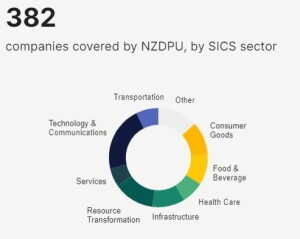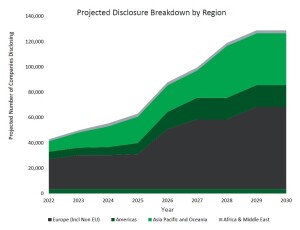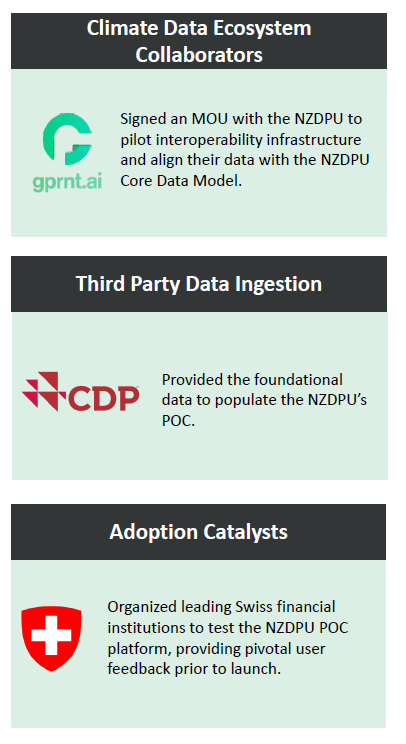Hurricanes, floods, heat waves, droughts: weather events are increasing in severity as the earth’s atmosphere warms. The consensus is that we need to reduce greenhouse gas (GHG) emissions. Yet recent reports show waning interest in initiatives such as Climate Action 100+.
“When performance is measured, performance improves,” according to Pearson’s law, and “when performance is measured and reported back, the rate of improvement accelerates.”
Such is the reasoning behind the data repository known as the Net-Zero Data Public Utility (NZDPU).
 On February 21, 2024, three panelists from NZDPU spoke about the “why” and the “how” of their new organization. The webinar was sponsored by the Global Association of Risk Professionals (GARP) and was moderated by Jo Paisley, President, GARP Risk Institute.
On February 21, 2024, three panelists from NZDPU spoke about the “why” and the “how” of their new organization. The webinar was sponsored by the Global Association of Risk Professionals (GARP) and was moderated by Jo Paisley, President, GARP Risk Institute.
The NZDPU has been in existence for less than two years. In June 2022, the Climate Data Steering Committee (CDSC), a special committee formed by French President Emmanuel Macron and United Nations Special Envoy Michael R. Bloomberg, called for the development of a climate data repository that would be unified, global and open. By November 2022, the NZDPU core team was formed.
Why a new data repository?
Governments, scientists, and public interest groups need data on how climate change is being addressed and yet the data is disorganized and not always readily available.

Simone Kramer, Head of Product at NZDPU, described data challenges that are hindering the transition to a net-zero economy. “The data lacks the granularity needed to assess its credibility and quality,” she said. “The data is behind paywalls or spread across numerous sources,” making it largely inaccessible to the average user. Also, “climate transition data lacks comparability across sources and entities,” she said. “The disclosure formats differ and there’s a variety of calculation methodologies.”
For these reasons, the CDSC pushed for a public utility that would provide transparency, availability, and comparability. NZDPU aims to become a “trusted central source of verifiable climate transition-related data.”
Each company is assigned to a Standard Industrial Classification category, or SICS code. The chart below shows the current SICS proportions of reporting companies.
The utility’s Technical Advisory Board (TAB) includes data management heavyweights such as MSCI, Moody’s and S&P Global. Kramer said, “The core data model is where the magic happens.” The Core Team, composed of experts in four fields (shown in figure below), guides the building of the NZDPU platform and coordinates the implementation of CDSC recommendations.
They are “bringing the vision to life via proof of concept,” and the NZDPU team showed a video.
As of the date of this posting, only 382 companies are listed in the database. [Editor’s note: Only eight Canadian companies appear; 104 American companies appear.] These companies in total produce 1.8 percent of direct global greenhouse gas (GHG) emissions. Clearly, there’s room to grow.
Kramer predicts a sharp ramp-up in disclosures, through both voluntary and mandatory reporting. The number of companies disclosing GHG emissions is projected to be 120,000 by the year 2030. The chart below shows these projections for the regions of Europe, Africa & Middle East, Asia & Pacific, and the Americas.
The NZDPU team relies on ongoing collaborations with climate data ecosystem initiatives such as Gprnt.ai, third-party data disclosure systems such as CDP (initially established as the “Carbon Disclosure Project” in 2000), and “adoption catalysts” or institutions that are leading the change.
Benefits of New Data Repository
“The NZDPU enables easy access to climate transition-related data,” Kramer noted, that will provide risk management professionals with the information needed for climate-risk mitigation strategies.
Risk managers can “identify and address potential climate-related reputational risks through easier comparison to their organization’s industry peers.”
She noted the data repository “facilitates comparison of companies based in jurisdictions using different climate disclosure standards and requirements.” This means experts can “better understand the short-term and long-term emissions reduction targets.”
Last, the new repository means “greater transparency to the methodologies used by companies to calculate their emissions.”
Test Drive
Following Kramer’s presentation, James Hawkins, Product Engagement Lead at NZDPU, demonstrated the user-friendly interface of the data search engine at the NZDPU website. Searching can be done on company name or the Legal Entity Identifier (LEI), which is a reference code used across markets and jurisdictions to uniquely identify a legally distinct entity that engages in a financial transaction.
The Q&A period had questions about the transition risk, as we move to a low-carbon economy.
Renwick Wilson, Product Analyst at NZDPU, said that a central repository will avoid redundant reporting processes. Tracking emissions targets will allow comparability. Companies often disclose their targets but currently there is no follow-through on whether they hit anywhere near the targets.
The panelists discussed the plans for the upcoming COP29, which will will be held in Baku, Azerbaijan in November 2024. “NZDPU will have some presence.”
The webinar concluded with Jo Paisley urging attendees to go the NZDPU website “and play around” with the data search tool.♠️
Visuals in this posting are from the GARP webinar, except for the solar cell array, which is from the CDSC annual report. Permission pending.
Click here to view the one-hour webinar featuring Jo Paisley and NZDPU presenters.








